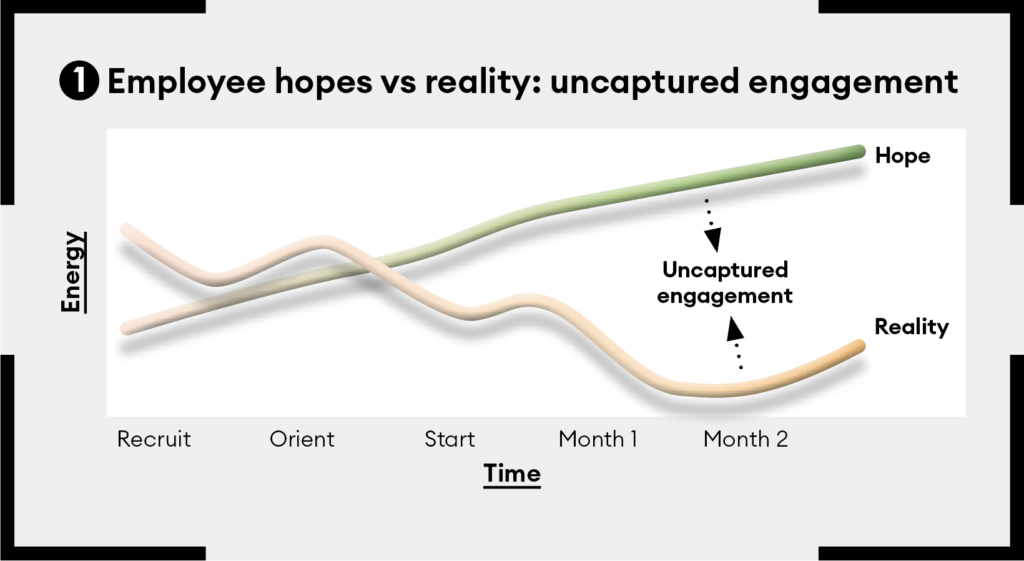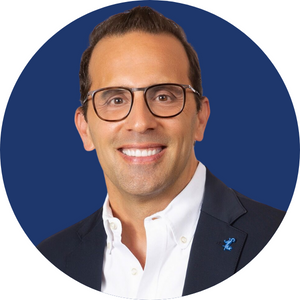Is rotten culture really the culprit in today’s crisis of employee engagement and retention – or is it instead a question of endemic misalignment between companies and talent?
If Albert Einstein was correct and the definition of insanity is doing the same thing over and over and expecting different results, modern organizations are in need of some serious therapy.
In a June 2022 Global Workplace Report, Gallup estimated the cost of lost productivity in the global workplace due to disengaged employees to be $7.8 trillion. That is 11% of global GDP, or nearly twice the market cap of Google, Amazon and Apple combined. What is most staggering about the number is that it has remained relatively unchanged despite ever-increasing expenditure by companies on the employee experience, on beautiful workplaces, employee engagement surveys, culture transformations, and leadership and manager development.
The lost $7.8 trillion signals a growing crisis of commitment in the modern workplace. We are struggling to keep our most-talented people engaged and motivated even though we have implemented the best practices of the most-engaged companies, trained our managers and leaders to be more inspiring and empathetic, and tried with all of our might to create cultures where our employees can thrive.
Culture – or fit?
As an organizational psychologist my first impulse when reading something about productivity and engagement (or lack thereof) is to consider what in our workplace cultures needs to change. So that’s what I started to do. Like any good researcher, I began by interviewing those that were easy to access – friends, family, current co-workers and past colleagues. Those early conversations were not conclusive: they didn’t directly point to culture being the culprit, or at least not to a divide between universally ‘good’ and ‘bad’ culture.
If the problem wasn’t culture per se, I started to wonder, could it boil down to alignment of expectations about how work is done day-to-day? In other words, could it come down to ‘right’ or ‘wrong’ fit? With this concept in mind, I sought out 50 interviews with talent ranging from 22-55 years of age, from early career talent to chief executives, from start-ups to global multinationals, working in locations from Asia Pacific to Europe to the USA. Here is what I learned.
I define right fit simply as a deep and authentic connection to how a company works day-to-day. It is the connection we have to the daily principles and practices of how work gets done, versus the affinity we hold for a company’s brand, purpose, values, or leadership approach. It is, in other words, the proverbial sausage-making.
When we have right fit – that connection to how a company works day-to-day – the days feel easier, the work is more meaningful, and our connection to our company grows exponentially. As one interviewee described it, “In my ‘right fit’ experience, it felt like putting on my favorite outfit. I was more me.” Another interviewee said, “You are putting in the hours, but it doesn’t feel like work.” Another related being “excited to show up for work every day. It felt like home.”
Perhaps even more compelling were the explanations of how people felt when fit wasn’t there. One of our interviewees said it felt as if “everyone has a secret decoder ring for success, except for me.” Another was much more raw about the feeling when they said, “It was like being punched in the face every day in a different way.” Another told me: “It was impacting my relationships, my mental health. I just didn’t want to go to work.”
Why is fit so elusive?
Where talent views right fit through the lens of alignment of ways of working, companies must view right fit in terms of their clarity, consistency, and commitment to a more singular way of doing work as a whole. This, unfortunately, is where many companies fail.
While companies have become adept at defining their mission, articulating their strategy, sharing their values, and crafting inspiring leadership expectations, few have done the hard work to understand how the work, done well, happens day-to-day. How does the company actually run? How does the company prioritize work, solve problems, innovate new ideas, manage conflict, give feedback, socialize projects, and so on? Each company does this in a unique and, at its best, totally natural way. Such ways of working are innate in the fabric of the company and often emanate from the early days of its founding, before external hires from other companies began to dilute the ‘special sauce’.
Not surprisingly, I found right fit experiences to be elusive. From a talent perspective, the way a company works is often undervalued in job searches when compared to the power of the brand, job title, better perks or higher pay. Interviewees often recalled that in their wrong fit experiences, they knew something was off early on, but they were blinded by other “shiny” elements. Indeed, it is nearly impossible for talent to assess fit effectively: across everything from job descriptions to employer branding to recruiting, companies present their aspirations far more often than the day-to-day reality of how it feels to work in the business. In this age of authenticity and vulnerability, companies such as Basecamp go as far as to publish blog posts or even books on their ways of working, unapologetically sharing who they are and how they work.
Without this sort of clarity and consistency from the first moment of recruiting through to the first 90 days, there is the potential for jarring dissonance. The hopes a new joiner has about who the company is, what their role will be and how it will feel to work there, can end up being very different from the felt experience. As Figure 1 shows, the result is uncaptured engagement and lost productivity.

On the company side, there is often a lack of clarity, consistency and transparency about how it gets work done. Many of our interviewees commented that they “bumped into the culture and ways of working on a daily basis, almost in a sink or swim sort of way”. Adding to the complication, companies rarely require leaders who join the company as it grows to learn or adopt the company’s existing ways of working. Thus, leaders bring with them their own best practices, their favorite tools and platforms, and their own operating model. The outcome is a slow, bureaucratic, confusing hairball of multiple leaders’ individual preferences about how work gets done. Remember that $7.8 trillion of lost productivity? Much of it likely lies right here.
Right fit is not about fitting in
Something else became clear as I explored right fit with the interviewees: the pressure many of us feel to ‘fit in’. If right fit is about whether the ways of working inside the company align with a person’s natural work preferences, fitting in is about a person trying to become something they aren’t in the hopes of one day being successful. When you have right fit, doing your best work is easy. It feels like you are writing with your dominant hand every day. When you don’t, all of your creative energy goes to context (fitting in) over craft (the core skill or capability you have built up over time). Work is harder, more stressful, takes higher levels of concentration and leaves you feeling drained.
Interviewees who spoke about wrong fit felt like they had lost opportunities to show the full potential of their craft due to endlessly trying to gain the “secret decoder ring” to fit in. The cost is staggering, both to the talent and to the company. The company doesn’t get the lift of captured discretionary effort nor the unique brilliance of the person they hired. Even worse, talent walks out of these situations feeling less confident, less capable and less themselves.
So, what can we do to create right fit experiences more often and regain some of that lost productivity? Below are a few strategies gleaned from the interviews.
Finding right fit for you
If you are a talent working in an organization or looking for a new place to join, it is vital that you gain a deeper and richer view of the work environments where you thrive and use this as the primary criteria for assessing your next opportunity. A few questions can help you.
- What values do you consistently hold when making big life decisions?
- What is the life you are trying to build? Where do you want to end up when you retire?
- What are you best at (versus what you love to do)? What is your superpower?
- Are you of company (you care most about the brand you work for), of craft (you care most about the depth of the technical skill you are building), or of cause (you care most about the impact you are having in the world)?
- What is true when you are at your best at work?
- Who is your ideal leader? How do they work day-to-day?
- If you built a company from scratch, how would you want work to get done day-to-day?
- What are you solving for right now? What do you need that you don’t have in your current experience? Why is it more important than everything else?
Finding talent with right fit for your organization
If you are a leader of a team, function, or company, it is vital that you gain clarity about the way your company works at its best. That process starts with understanding how work gets done day-to-day. The box, right, sets out questions that can help clarify or rediscover your company’s way of working. Once the ways of working are more clearly understood, it is important to turn them into easy-to-understand work principles, practices, and platforms.

Work principles
What are the norms for how we work? How do we want work to feel? These principles are overarching statements of intent like “the consumer decides”, or “asynchronous first, meetings second”, or “we work in full sentences, not beautiful decks”. These principles are often set at a company’s founding and are core to what differentiates you.
Work practices
What are the methods, tools, and approaches for how work gets done day-to-day? These are much more about how we do work. For example, your company might use design thinking to solve problems. You might write two-page memos when presenting a new idea, or you might use a certain framework (e.g. objectives and key results) to cascade goals and communicate strategy.
Work platforms
What is the tech stack that enables the principles and practices to be true for everyone every day? Think about this as the technology platforms that enable work practices (e.g. Miro, Basecamp, 15Five, Monday, Teams, etc.) Often, we don’t choose the platform that best enables our preferred ways of working; when the technology doesn’t enable our work preferences, investment fails to return value.
Once an organization has clarified the ways of working, then the real work begins. Employees at all levels of the organization must be ‘re-recruited’ to work this way. The most senior leaders must model these ways of working. Touchpoints with talent (recruitment, onboarding, development, town halls, internal communications and so on) must signal their importance. And performance management process must reinforce them.
Is the juice worth the squeeze?
With $7.8 trillion of lost productivity globally, the number of employees who wake up every morning dreading turning on their computer or heading into work is staggering. They are not reaching their potential, showcasing their talents, or feeling like the time spent away from their families is worth anything more than a barely equitable salary.
As a result, companies are not creating the value they could for their customers. The net-net? Nobody is truly winning. We can do better. We must do better. Focusing on right fit is a good place to start.




